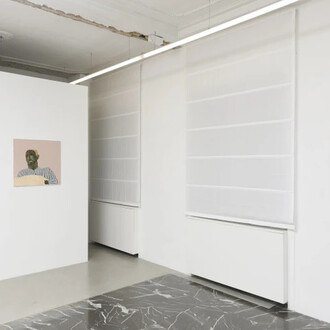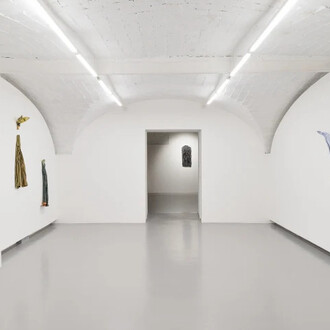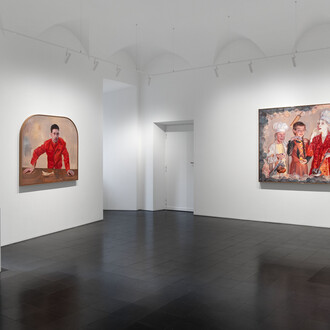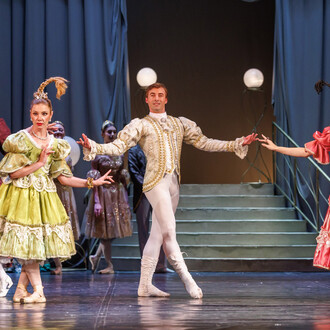The Gallery Apart is proud to present Molto Visibile, Troppo Invisibile (Very Visible, Too Invisible), the new project by Gea Casolaro through which the artist offers her contribution to the ethical and moral question about the fate of our planet as well as the individual and collective consciousness. The exceptionality of the current times, the uncertainty of the stability of the democratic institutions, the materialisation of a catastrophic environmental scenario, the tragic inability to prevent and manage the migration flows and the resulting nationalist and racist instincts lead Gea Casolaro to suggest interpretations that eschew an excessively abstract approach from the problems, an attitude which is itself origin and concause of the difficulty in finding solutions.
Such ambition to concreteness underlies the artistic practice of Casolaro. The investigation into the several ways of vision, on which the artists has based most of her poetics, is used to launch meaningful connections aimed at generating doubts and reflections in the viewer. An inclination towards multidimensionality already transpired from her past photography exhibitions, but the need to incorporate the plurality of views, as well as the urge to foster critical masses in order to challenge the contemporaneity, to Casolaro represent the reason for adopting new approaches in her artmaking practice. Hence, on one hand her predilection for processes of engagement and participation in creating her artworks and on the other hand her experimentation, as opposed to the compulsive use of the images of today’s communication.
The project Molto Visibile, Troppo Invisibile is also the result of this creative approach. Along with the philosopher Enrico Castelli Gattinara, Casolaro has invited some renowned speakers to take part in the talks held in the gallery spaces with the aim of exploring topical issues from even eccentric, but never dull points of view. From these meetings the artist has drawn the material to create the video from which the exhibition takes its name. At the same time, she has worked with a group of young foreigners arrived in Italy, intentionally outside any classification (regular/irregular, asylum seeker, refugee, economic migrant), to underline the common belonging to one humanity whose members, nobody excluded, should be guaranteed the fundamental rights, including the right to dream of a better future. Her work shows how the desire of several migrants is first and foremost that of improving themselves. And the artist urges to reflect on how these ambitions and this energy may revitalize our exhausted societies.
As in all her works, Casolaro acts by elicitation, exploiting the powerful images that take shape and unfold in her mind and that she brings to the attention of who, through art, calls if not for solutions, at least for credible interpretations. The need for concreteness exhorts the artist to reify her goad-images in real tridimensional objects. Thus, sculpture pieces stand alongside the videos and the works of participatory art, which Casolaro manages to treat for what they are: pure images. The sweatshirt with the symbol from the costume of Ubu Roi to evoke the many, homebred and not, Ubus, whom the fate of the Nations and civil coexistence have to face. The telescope aimed at a physical planisphere significantly entitled Il cielo stellato e la legge morale (The starry sky and the moral law), inspired in a Kantian-like way by the need to reflect upon our own role on this planet that has to be protected and preserved in its entire and precious universality, without any boundary, distinction nor economic interests. And Specchio delle mie brame, powerful anti-monument to incommunicability and to a distorted view of reality which characterizes today’s communication. Finally Torno subito, an incitement to reclaim our role as sentient and rational women and men after a too long, and still ongoing, intellectual break: the ringing of an alarm clock, or of a bell, which Casolaro entrusts to a message on a T-shirt significantly left white.
Gea Casolaro was born in Rome (I) in 1965. She leaves and works between Rome (I) and Paris (F) Her twenty-year long work explores the relationship with the images, the contemporaneity, the society, and history, through photography, video and writing. Her research aims at triggering an ongoing and permanent dialogue between the experiences and people, in order to expand the analytical skills to examine reality through different points of view. With an approach that evokes the practices of sociologists and philosophers, urban landscapes and their dwellers catch our attention: Human landscapes is the title of a series created between Berlin, Rome, Buenos Aires and Shanghai since 1997, whereas Visioni dell’EUR (2002-2006) portrays landscapes from neighbourhoods, synonym for modernity in the Sixties and therefore chosen by the greatest Italian film director as a “supporting actor” of their films.
She won the Suzzara Prize in 1996. In 1988, she took part in the talks of the Biennial of Young Artists from Europe and the Mediterranean which took place in Sarajevo. In 2003 her video-installation, created in Buenos Aires (Doppio sguardo, 2003), featured in the XIV Anteprima- Quadriennale in Naples; in 2008, a video-installation to commemorate those who have died in workplace incidents (Ai caduti di oggi, 2008), was showcased during the XV Quadriennale at the Palazzo delle Esposizioni in Rome. Among her most important projects are: Maybe in Sarajevo in 1998, a poetic tribute to the city as a crossroads of cultures and religions, devastated by years of war; the video Volver atrás para ir adelante shot in Buenos Aires in 2003, during the economic crisis, featuring scenes of street life, protests, demonstrations, distracted passers-by, facing the dreadful events of the dictatorships in the Seventies. The video was presented in several venues and exhibitions, such as the Teatro India in Rome, the Festival International de Cinéma Vision du réel di Nyon in Switzerland, the Raid Project in Los Angeles, and in 2007 at the One World Berlin Filmfestival.
The work Permanente presenza, commissioned in 2007 by the Mart, was showcased in a solo exhibition at the Contemporary Art Museum in Trento and Rovereto (Italy); 2010 was the year she created the image of the CGIL trade union membership card on occasion of the 40th anniversary of the approval of the Workers’ Charter, and the solo show South at the The Gallery Apart in Rome featuring two works on the perception of the landscape produced in New Zealand and France, respectively. In 2009 she spent nine months on an artist-in-residence programme at the Cité Internationale des Arts in Paris (France) to work on her project Still here focused on the relationship between cinema and everyday life in the French capital. In 2011, she exhibited in the Italian Pavilion during the 54th Art Biennale of Venice, at the Italian Cultural Institute in Strasbourg (France), and in 2012 at the Festival Images in Vevey (Switzerland).
The project Sharing Gaze dates back to 2013. It is the product in two chapters of the workshop carried out with a group of students in their final years of the Fine Arts Academy in Addis Abeba during her artist-in-residence at the local Italian Cultural Institute, and Mille e una di queste notti, first public screening of the video, for the fourth anniversary of the earthquake at the MU.SP.A.C. Museo Sperimentale d’Arte Contemporanea in L’Aquila (Italy). Still in 2013 she realized two commissioned photo exhibitions: the first in the Principality of Monaco (the work Forever Monte-Carlo was exhibited at The Forbes Galleries in New York); the second in Luxembourg at the CNA Centre nationale de l'audiovisuel, where she carried out a portrait of the complex multi-faces of the Country through a relational mail-art exhibit, titled Send Me a Postcard, a site aside, inside, in between, away.
In 2015 she participated in a residency programme for more than two months at the Italian Cultural Institute in Lima for a participatory art project inspired by the work of the Andean photographer Martín Chambi, with the participation of a group of students of the Centro de la Imagen. In 2016, she won the competition of the Comune di Casale Monferrato (Italy) for the creation of a public art monument for the Parco Eternot on the same site where once the notoriously famous Eternit factory was built, whereas in 2019 she created the permanent art installation Arbor vitae – Giù le armi dalle mani at the Mufar – Museo Fabbrica d’Armi delle Reali Ferriere di Mongiana.
The sweeping retrospective exhibition Con lo sguardo dell’altro was inaugurated in 2017 at the Macro Museum in Rome, curated by Claudio Crescentini, it was hosted in two halls of the museum and in the video rooms and also extended to an display of its most significant catalogues and books in the museum library. Between 2017 and 2018 Casolaro created two important participatory art projects, both in Rome, involving groups of people who from time to time took part in the creative process: Il legame con la storia libera l’immaginazione, with the students of the Liceo Classico E. Q. Visconti, and Nel corpo della città, a multi-site exhibition which unfolded between the Museo Laboratorio della Mente, the Archivio Storico Capitolino and the Biblioteca Nazionale Sportiva of CONI.
Featured in the prestigious Donata Pizzi Collections, her works have been showcased at the International Exhibition of Triennale Milano, at the Palazzo delle Esposizioni in Rome, and at the Museo di Santa Giulia in Brescia, all venues that have hosted the Collection. Selected in 2017 by the artists presented in Corea at Casa Italia on the occasion of the Winter Olympic Games, in 2019 the Italian Cultural Institute in Lisbon dedicate her the solo exhibit “Riflessioni”, whereas Gaia Bindi and Piero Gilardi have invited to participate in the exhibit “Resilienza/Resistenza” at PAV – Parco Arte Vivente in Turin (Italy).
Works by Casolaro are exhibited in important public and private art collections, such as: MAXXI Museo Nazionale delle Arti del XXI secolo, Rome; CNA - Centre National de l’Audiovisuel, Dudelange, Luxembourg; Mart - Museo d’Arte Contemporanea in Trento and Rovereto; MU.SP.A.C. Museo Sperimentale d'Arte Contemporanea in L'Aquila; Collezione Farnesina Experimenta, Ministry for Foreign Affairs, Rome; Collezione della Fondazione Quadriennale in Rome; Collezione CGIL Confederazione Generale Italiana del Lavoro, Rome; Pinacoteca Comunale in Terni; Collezione Provincia Autonoma di Bolzano; Collezione storica del Premio Suzzara; Monumento Parco Eternot Comune di Casale Monferrato; Museo Laboratorio della mente, Rome; Mufar, Museo delle armi delle Reali Ferriere Borboniche, Mongiana.
















